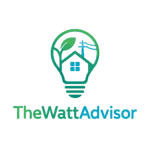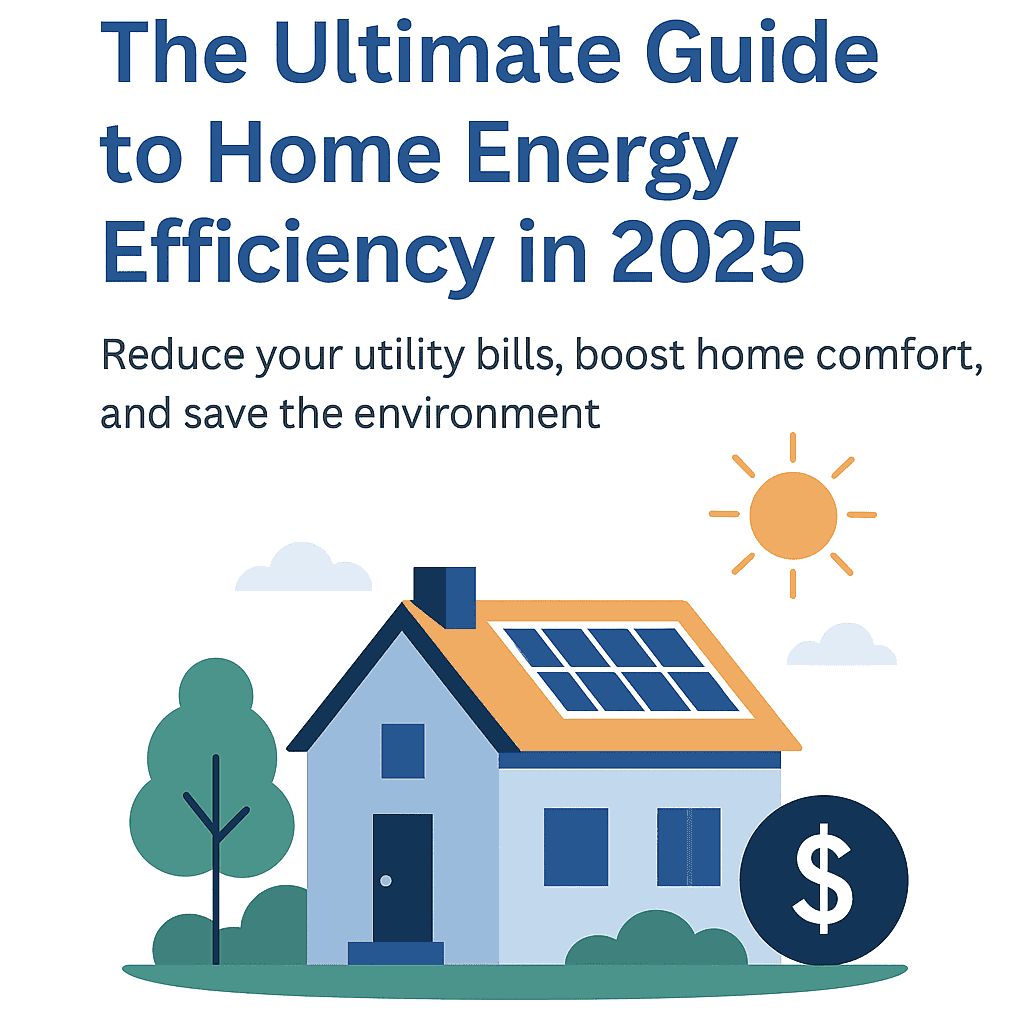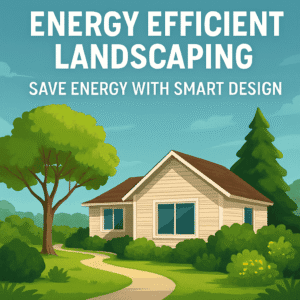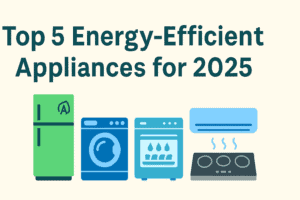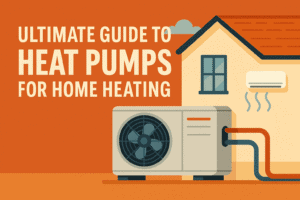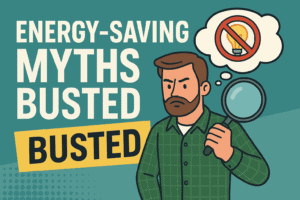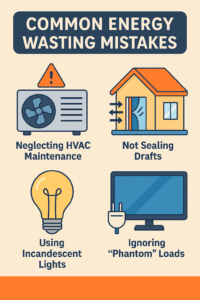The Ultimate Guide to Home Energy Efficiency in 2025: Save Money & Boost Comfort
The Importance of Home Energy Efficiency
Energy prices are rising globally and homeowners are increasingly focused on home energy efficiency. Efficient homes mean lower bills, improved comfort, reduced carbon emissions, and enhanced resale value. In 2025, combining proven strategies — insulation, air sealing, HVAC upgrades, smart gadgets — will maximize energy savings and environmental impact. This guide brings together actionable insights and evidence-based techniques to help you upgrade your home effectively.
Understanding Home Energy Efficiency
Energy efficiency is about using less energy for the same level of comfort and functionality. This involves reducing heat loss, optimizing appliances, improving HVAC system performance, and using data-driven habits. Efficient homes perform better, cost less to run, and offer a higher return on investment. We’ll explore each of these pillars in detail.
Conducting a Home Energy Audit
A comprehensive energy audit is the foundation of efficient home improvements. This can be a DIY approach described in How to Perform a Home Energy Audit: Step-by-Step Guide, or a professional audit involving blower-door tests and infrared thermography. Identifying problem areas guides you toward the highest ROI upgrades, focusing on insulation, air leaks, appliances, and HVAC systems.
Air Sealing: Eliminate Hidden Drafts
Gaps around windows, doors, pipes, and attic access can waste 5–30% of heating or cooling energy. Use caulks, spray foam, foam board, and weather stripping to seal these areas. A tightly sealed building envelope keeps air where it belongs — indoors — and improves comfort dramatically.
Attic, Wall & Basement Insulation
Proper insulation acts like a thermal blanket. Achieve energy efficiency by adding the right R-value insulation to attics, walls, and basements. Check out our detailed guide on Best Insulation Materials for Energy Savings in 2025 to compare options like fiberglass, spray foam, mineral wool, and cellulose.
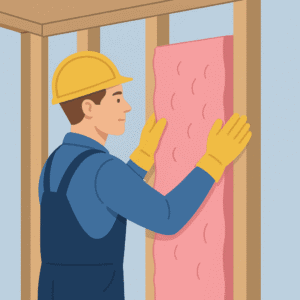
Installing Energy-Efficient Windows & Doors
Old, single-pane windows are major energy culprits. Upgrading to double- or triple-glazed ENERGY STAR windows with low-E coatings can reduce heat loss by over 50%. Add foam or rubber weather stripping and door sweeps to prevent drafts—simple solutions with big results.
Upgrading Heating & Cooling Systems
HVAC systems account for up to 50% of household energy use. Smart strategies include:
- Replacing old HVAC units with ENERGY STAR models
- Installing smart thermostats, such as in our Smart Thermostats Guide
- Regular maintenance (clean filters, duct sealing, refrigerant checks)
- Zoning systems and efficient air distribution
Smart Thermostats & Programmable Controls
Smart thermostats learn your routine, optimize heating and cooling schedules, and can save you 10–15% on energy bills. They reduce wasted energy through geo-fencing and remote control via apps. Learn more in How Smart Thermostats Save You Money.
Lighting Upgrades
Lighting accounts for 10–15% of energy use. Switch all bulbs to high-quality LEDs; add occupancy sensors, timers, and daylight-harvesting systems. Lower wattage, longer lifespan, and instant brightness — LEDs are an easy win for home energy efficiency.
Appliances & Electronics
Old appliances can waste large amounts of energy. Replace inefficient units with ENERGY STAR-rated refrigerators, dishwashers, washers, and dryers. Use smart power strips to eliminate vampire loads. Check out our Top 5 Energy-Efficient Appliances for 2025 for vetted model recommendations.
Water Heating Efficiency
Water heating can be 15–30% of energy bills. Solutions include:
- Passive solar water heating
- Tankless or heat-pump water heaters
- Insulating tanks and pipes
- Lower water settings on dishwashers and washing machines
Windows Treatments & Solar Control
Prevent energy loss with low-E film, insulated shades, blackout curtains, and reflective blinds. These block unwanted heat gain or loss, supplementing insulation and HVAC systems in cost-effective ways.
Utilizing Solar & Renewable Energy
Solar systems can offset electricity use completely. Explore our Solar Panels vs Solar Roofs guide to choose the right option. Consider adding battery storage for maximum savings and backup power.
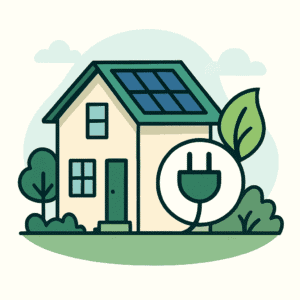
Smart Plugs, Power Strips & Appliances
Use smart plugs to schedule and monitor device use. Set appliances to run during off-peak hours. Monitor usage patterns and adjust behavior based on insights. These tactics drive steady progress in home energy efficiency.
Behavioral Changes & Rebound Awareness
Be mindful—reducing heating costs may lead to behavioral rebound (e.g., heating more). Use habit-tracking, energy dashboards, and apps to stay on track. Research shows smart feedback reduces home energy use by up to 15%.
Evaluating Rebates & Incentive Programs
Use programs like the US Federal Solar ITC (30% tax credit), ENERGY STAR rebates, and state/local incentives. They reduce installation costs and shorten payback periods for upgrades like HVAC, solar, appliances, and insulation.
Monitoring Energy Use Over Time
Track your home’s energy use with tools like Sense, Emporia Vue, or utility dashboards. Compare pre- and post-upgrade usage. Identify unexpected energy spikes or inefficiencies and act promptly—this is key to sustained home energy efficiency.
Maintaining Efficiency: Schedule & Checklist
- Inspect HVAC systems twice yearly
- Re-inspect attic insulation yearly
- Replace filters monthly
- Caulking/weatherstripping check annual
- Lighting/appliance check and upgrade triennially
- Consistent maintenance protects your home energy efficiency investment.
Eco-Friendly Home Improvements
Complement energy savings with green upgrades: low-flow plumbing fixtures, native landscaping, rainwater harvesting, passive cooling roofs. These synergize with energy measures to reduce carbon footprint.
Cost vs Savings Calculator
A carefully modeled ROI can guide decisions. Use our Energy Cost Calculator Tool linked in the intro. Pull energy consumption data, insulation costs, and estimated savings to prioritize improvements for optimal ROI.
Case Study: Real Home Energy Efficiency Challenge
Example: A 1,800 sq ft home in Ohio did a DIY audit: sealed leaks, attic insulation upgrade, smart thermostat install, appliance replacements. Results: 40% heating savings, 25% electricity savings, full payback in three years.
Energy-Saving Myths Clarified
Debunk common myths (e.g., “closing vents saves energy,” “dark paint helps heat”), and explain proven methods align with this guide’s evidence-based strategies. Link to Energy‑Saving Myths Busted: What Really Works? for deep dives.
Summary & Next Steps
Energy efficiency in 2025 means combining envelope improvements, efficient systems, smart devices, renewables, and behavioral changes. Start with an audit, focus on insulation & HVAC, proceed with smart controls and renewables, and monitor continuously. Keep your upgrades coordinated for best performance.
FAQs
What is home energy efficiency?
Home energy efficiency refers to using less energy to achieve the same level of comfort and performance in your home. This includes improvements like insulation, air sealing, using smart thermostats, and upgrading appliances to ENERGY STAR-rated models.
What are the best ways to improve home energy efficiency in 2025?
Top strategies include upgrading insulation, sealing air leaks, installing smart thermostats, switching to LED lighting, replacing old appliances with energy-efficient ones, and considering renewable energy options like solar panels or roofs.
Do smart thermostats really save energy?
Yes, smart thermostats can reduce heating and cooling bills by 10–15% by automatically adjusting temperatures based on your schedule and preferences. They also provide remote control and energy usage data for better decision-making.
How much can I save by improving home energy efficiency?
You can save anywhere from 20% to 50% on annual utility bills depending on your home’s current condition and the upgrades you implement. Some changes have a payback period of just 1–3 years.
Is solar power worth it for my home in 2025?
Yes, solar is more affordable than ever. With a 30% federal tax credit in the U.S. and falling equipment prices, solar panels or solar roofs can significantly lower your electric bills and increase your home’s value. Explore our comparison at Solar Panels vs Solar Roofs.
This Post was on The Ultimate Guide to Home Energy Efficiency in 2025: Save Money & Boost Comfort
